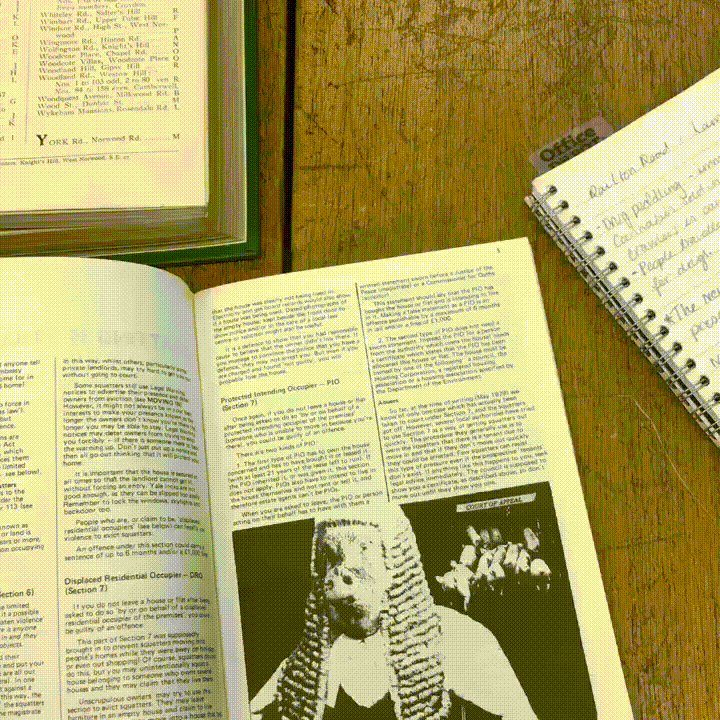
Lambeth Archives



Lambeth Archives is the first archive we visited as part of the Voices From The Front Line project, and for some of us, the first archive visit ever! We learnt about the importance of archives, what an archive is, how to behave when you're in an archive and how to handle them. We were given archival material that related to Railton Rd such as maps, newspaper clippings and publications all of which will contribute to our timeline. Taking a look at the squatters hand book was useful as it too helped us put into perspective how different Railton Rd was, and how it was viewed in the 1980's by the council the police and the media.
Black Cultural Archives
Sarah Buntin the facilitator of the BCA Workshops, discussed significant individuals who used Railton road as a space to organise or socialise. We also learnt how to do oral histories. We generated interview questions that would help us get a good insight about peoples experiences of Railton road. We then had a 'living archive' workshop, where we met Melba Wilson, a founding member of the Black Women's Group, and she shared some of what took place with activist groups on Railton Road. It was good to learn about the road through her perspective.
Autograph ABP








Going to Autograph ABP was a really fun experience, for most of us it was our first time. Our facilitator, Ali Isa, showed us original artwork, prints of artist Rita Keegan (who we always see at the 198) and work from Rotimi Fani - Kayode, an artist we had researched about who lived on Railton Road. We learnt of the significance and politics of his work, especially being a gay Nigerian photographer, using his artwork to challenge homophobia, and how he co-founded Autograph ABP. We also did a role play workshop, reenacting scenes and characters from Rotimi's work. After our workshop we were taken to watch some of Sam The Wheels films. A lot of us see him fixing his bikes when we walk up to 198 from Brixton and didn't know that he used to make films let alone had them showing in an art gallery.
It really puts into perspective how important he is for the documentation of Black British history. Sam's films showed footage of people in Brixton shopping, people at church, and scenes from after the first uprisings. We also learnt about Jamaica in the 1890's, as Autograph had an exhibition 'Making Jamaica', of archives painting a picture of what life was like at that time in the Caribbean. It was really significant for us because a lot of our group are of Afro-Carribean heritage, and have never seen images of where our parents and grandparents come from, at least not of this particular time.
George Padmore Institute
Sarah from the George Padmore Institute offered an informative session about the archives, how they are stored, used and donated. She shared a number of relevant documents that were inspiring ideas for our design work. We really enjoyed the design element of the practical workshop where we had to create a political slogan for a T-Shirt based upon some of the slogans we found in the documents relating to the New Cross fire demonstration.
13 Dead Nothing Said
The visit to 13 Dead Nothing Said at Goldsmiths University of London was also a first for most of us. We made links between the political figures we came across at George Padmore such as Darcus Howe, who's funeral procession took place on Railton Road and Linton Kwesi Johnson who popped in whilst we were there. They were both key figures involved in the New Cross fire demonstration. Interesting questions were asked about the images they saw such as; “Why did white people march during the Black Peoples Demonstration?” “Would people march if that happened to one of us today?”
The Cinema Museum



The Cinema Museum gave us a different perspective of London during the mid 1900’s. We focused on the cinema at 222 Railton Road as one of the early silent film spots. We learnt of the history of local resident Charlie Chaplin who may have been a frequent visitor to the Railton Road area.
National Archives

Thanks to Sandra Shakespear, visiting the National Archives was so much fun. Firstly, we didn't think it was going to be as big as it was. All the other archives were tiny in comparison! We first had time to look at the exhibition display, where we learnt of old top secret spy documents, saw drawings of pre-colonial Africa and much more cool and interesting stories. We then had a grand tour of the National Archives, going though the storage spaces (massive), looking at maps, learning that it's possible to trace your family history. We then did a workshop with Decolonising the Archives, they helped us to re-interpret the archives that NG had that linked to Railton road. We re-enacted a letter from Rastafarian Naphtali to Lord Scarmen, wrote a poem based on a letter written by Olive Morris, touched the beautiful handwriting of Winnifred Atwell and created narratives for a person who had submitted a salt spoon spreader design to copyright and more.
